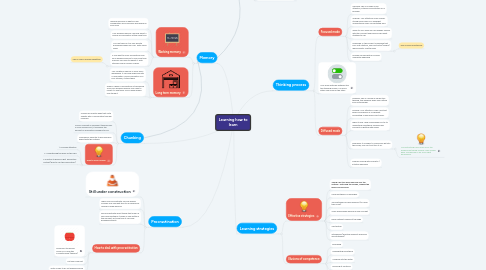
1. Chunking
1.1. Chunks are mental leaps that unite sperate bits of information through meaning
1.2. Once a concept is chunked it takes up less in your memory slot, it increases the amount of information available to you.
1.3. Chunking is essential to becoming an expert with the material
1.4. How to form a chunk
1.4.1. 1. Focused attention
1.4.2. 2. Understandig the basic of the idea
1.4.3. 3. Practice to help you get big picture context (how to use this information)
2. Memory
2.1. Working memory
2.1.1. Working memory is what you are immediately and conciously processing in your mind
2.1.2. Your working memory can hold about 4 chunks of information at the same time
2.1.3. You can think of it as your private blackboard where you can write some ideas
2.1.4. If you want to move information from your working memory to your long term memory you have to repeat it with intervals over a number of days
2.1.4.1. This is called 'Spaced Repetition'
2.2. Long term memory
2.2.1. Your longterm memory is more like a warehouse. It can hold large amounts of inromation. Once information is in your storage, it stays there.
2.2.2. When a chunk of information is transferred from your working memory you need to revisit it a few times so you know where you stored it.
3. Sources:
3.1. Oakley, Barbara (2014) "A mind for numbers." Penquin
3.2. MOOC Course: Learning How to Learn: Powerful mental tools to help you master tough subjects https://www.coursera.org/learn/learning-how-to-learn?
4. Procrastination
4.1. Still under construction
4.2. When you procrastinate you are levaing yourself only enought time to do superficial focused-mode learning
4.3. We procrastinate about things that make us feel uncomfortable. It helps us feel better in the moment, but long term it can have damaging effects
4.4. How to deal with procrastination
4.4.1. Pomodoro technique: Timer on 25 minutes 5 minute break (reward!)
4.4.2. Eat your frog first
4.4.3. Write a daily to do list evening before
5. Thinking process
5.1. Focused mode
5.1.1. Meaning: This is a mode of full attention, intense concentration on a problem.
5.1.2. Analogy: Your attention is like a super strong small beam of a flashlight. Illuminating a small concentrated area.
5.1.3. When to use: When you are already familiar with the concept and have an idea what strategy to use.
5.1.4. Downside: In this mode it is possible that your first intuition, your first initial (simple) idea prevents a better idea.
5.1.4.1. This is called 'Einstellung'
5.1.5. Problem solving with a focused sequential approach
5.2. Your brain switches between the two thinking modes. You are in either one mode or the other
5.3. Diffused mode
5.3.1. Meaning: This is a mode of big picture thinking, this happens when your letting your mind wander.
5.3.2. Analogy: Your attention is like a soft but super broad beam of a flashlight. Illuminating a large area in soft focus
5.3.3. When to use: Ideal mode when you try to understand something, learning new concepts or getting new ideas.
5.3.4. Downside: It is harder to conciously get into this mode, you can't just turn it on.
5.3.4.1. Try distracting yourr brain from the problem by taking a break. Take a walk, have a powernap or do some light housework.
5.3.5. Problem solving with a holistic / intuitive approach
6. Learning strategies
6.1. Effective strategies
6.1.1. Taking a picture walk: glancing over the material . Watching the images, reading the heads and summary
6.1.2. Using metaphors or analogies
6.1.3. Time between focused sessions (no more than a day)
6.1.4. Small doses when learning a new concept
6.1.5. Recall without looking at the page
6.1.6. Self testing
6.1.7. Interleaving (practice different problems and strategies)
6.2. Illusions of competence
6.2.1. Rereading
6.2.2. Highlighting everything
6.2.3. Jumping into the water
6.2.4. Glancing at solutions
6.2.5. Overlearning
